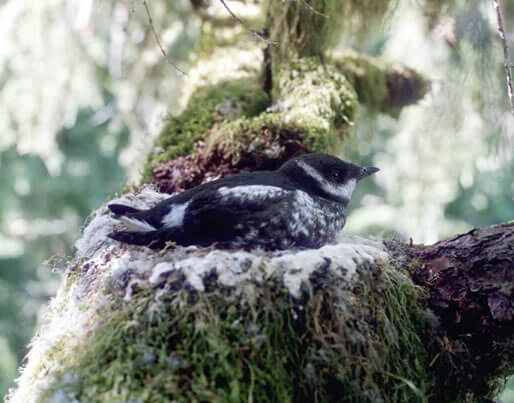BLM Plan Threatens Marbled Murrelet, Sets Back Forest Recovery Taking Place Under Northwest Forest Plan

The Marbled Murrelet nests on the branches of mature and old-growth trees. Photo by Thomas Hamer of Hamer Environmental.
Contact: Steve Holmer, sholmer@abcbirds.org, 202-888-7490
(Washington, D.C. May 16, 2016) The Bureau of Land Management (BLM) is proposing a final forest plan for the forests it manages in Oregon that weakens existing protections for the threatened Marbled Murrelet and Northern Spotted Owl. These protections were put in place in 1995 as part of President Clinton's Northwest Forest Plan.
American Bird Conservancy (ABC) has submitted a letter to BLM, and is urging Obama administration officials to shelve the proposed plan and to keep the Northwest Forest Plan in effect until it can be updated next year in conjunction with the Forest Service.
“The Marbled Murrelet is an endangered species being placed at great risk by the BLM's plan to increase logging in mature forests,” said Steve Holmer, ABC's Senior Policy Advisor. “The Northwest Forest Plan provided for half-mile buffers needed to mitigate for the heavily fragmented landscape. This common-sense safeguard must be retained.”
The Marbled Murrelet nests on large branches of mature and old-growth trees. It is listed as a threatened species under the Endangered Species Act because of habitat loss caused primarily by logging of old-growth forests. An estimated 19,000 birds remain, but the Washington State population is currently in a steep 5.9 percent annual decline, and long-term population projections indicate a high risk of extinction in California and Oregon within the next 100 years.
Marbled Murrelet nests suffer heavier predation in areas where the forest is not intact. Clearcutting proposed in the BLM plan for Oregon will further fragment the landscape. The current buffers protect 503 acres of habitat based on a circular radius from the nest site. A 300-foot buffer provides for only 6.5 acres of protected habitat, a 98% reduction from the current standard.
The BLM plan calls for commercial logging that is not focused on restoration of late-successional conditions in the reserves, which raises doubt that they will function as intended. The Northwest Forest Plan would increase the amount of carbon stored in the area over the next 100 years by 82 percent, reducing the amount of heat-trapping gas in the atmosphere. But the BLM plan would sequester much less carbon: only 44 percent, a blow to efforts to fight global climate change.
In the system of late-successional reserves, the loss of carbon storage is even more glaring. The Northwest Forest Plan anticipates that reserves will have a 100 percent increase in carbon sequestration. Under the BLM plan the reserves, which will be heavily logged, will only store 58 percent more carbon.
The BLM plan is proposing a five-to-eight-year moratorium on owl take until a Barred Owl control program is initiated in the planning area. Research on the effectiveness of Barred Owl removal has just begun, and uncertainty remains as to how much Barred Owl control the public will support over the long term.
“The Northern Spotted Owl will benefit from the proposed moratorium on take, but its habitat is at greater risk over the long-term because of the extensive logging planned in the late-successional reserves,” said Holmer. “We advise placing a much longer moratorium on owl take. In about 30 years, a large amount of new, suitable owl habitat will become available under the Northwest Forest Plan as forests mature. We need to stay the course and be as protective of the owl as possible until then.”
###
American Bird Conservancy is the Western Hemisphere's bird conservation specialist—the only organization with a single and steadfast commitment to achieving conservation results for native birds and their habitats throughout the Americas. With a focus on efficiency and working in partnership, we take on the toughest problems facing birds today, innovating and building on sound science to halt extinctions, protect habitats, eliminate threats, and build capacity for bird conservation.


















































